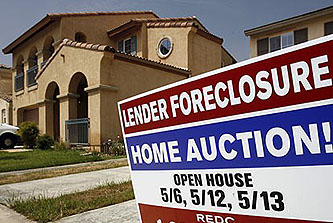 So how’s the housing market looking? Well, prices seem to have stabilized and foreclosure rates are down. Hooray! But Mark Gimein warns that the news is not actually as happy as the realtors’ PR machine would like you to believe:
So how’s the housing market looking? Well, prices seem to have stabilized and foreclosure rates are down. Hooray! But Mark Gimein warns that the news is not actually as happy as the realtors’ PR machine would like you to believe:
Consider, for instance, California. In the first quarter of 2009, according to the Mortgage Bankers Association, banks started foreclosures on 2.15 percent of all mortgages (that is, roughly one in 50). In the last quarter — the latest period for which data are available — that was down to 1.34 percent, a sizable drop….
But if you conclude from this that more folks have gotten their arms around their mortgages, think again. The number of new foreclosures may have dropped, but the number of people seriously behind on their mortgages has risen — from 4.75 percent of mortgage holders all the way up to 6.93 percent, an increase of close to 45 percent….Thanks to some combination of government pressure, genuine efforts at loan modifications, and reluctance to seize houses and try to sell them in a dismal market, banks are simply letting more debtors fall behind without foreclosing.
….The Realtors’ association happily reports that housing prices are rising because of tightening “inventory” — the trade term for “fewer houses for sale” — but underneath this is the scary reality that there are ever more folks seriously behind on their loans and waiting for lenders to take their houses and condos. This is something that lenders are reluctant to do because they still have no one to sell them to. The housing market looks stable only because lenders are avoiding flooding it with foreclosed properties.
There’s something more fundamental at work too: housing prices may have stablized recently, but they’ve done so at a level quite a bit higher than their pre-bubble value. Now, I’ve long thought that when the housing crash is finally over, prices might actually end up somewhat higher than their historical trend rate, but even if I’m right (never a sure bet) my guess is that prices might end up 10-20% higher, not 30-40% higher, which is where they are now. Bottom line: the housing market still has a ways to fall, and when the foreclosure moratorium finally ends it’s likely to spark another 20% fall in housing values. Or maybe more. The fat lady hasn’t sung yet.








